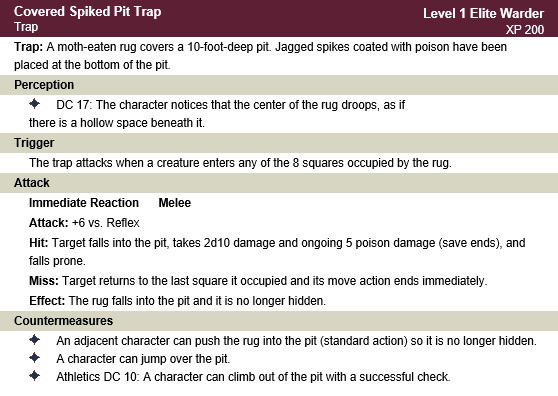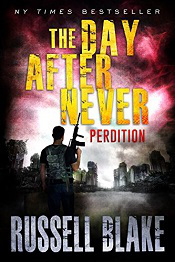Consider the lowly pit trap. It is basically a hole in the ground, covered with something. You fall in, you get hurt. You receive a predictable amount of damage according to the rules of your system – in 4e, that would be 1d10 damage per 10 feet fallen. More dangerous ones have spikes which might be poisoned.
Now consider this:

All that for a hole in the ground with poisoned spikes in it. Does this format really make it easier to find information? Do I need a stat block to tell me a character can jump over the pit? Or that a character can push the covering into the pit? Would I not have been able to figure that out on my own?
Worse yet, will I think to look at the not-always-appearing trap description in the stat block, when describing the scene to my players? This is the problem with text bloat, it obfuscates rather than illuminates.
I hadn’t really thought about simplifying the stat blocks until I was looking at the random trap generator on Donjon. I just now rolled 10 random traps, and this was number 10:
Concealed Pit (Perception DC 10 to find, Thievery DC 15 to disable, Single-shot, Melee 1, Attack +4 vs. Reflex, Damage 2d10+3 falling, 25 xp)
Do I really need more that that? Maybe the type of lid, as discussed in certain Hack & Slash articles. And this type of stat block also works for more complicated traps:
Prismatic Blaster (Perception DC 21 to find, Thievery DC 21 to disable, Init +2, Target 3 creatures within 10 squares; Attack +13 vs. Fortitude, Damage 2d6+5 poison and the target is slowed (save ends); Attack +13 vs. Reflex, Damage 2d6+5 and ongoing 5 fire (save ends); Attack +13 vs. Will, Damage 2d6+5 psychic and the target is stunned (save ends); 500 xp)
Does anyone not know what that does?
Its not just traps, either. Here is a disease stat block:

That is at least easy to refer to. But consider this randomly generated disease:
Phrenic Flux (Attack +4 vs. Will, Endurance DC 15 to improve, DC 10 to maintain, Effects: apathy (-2 to Cha checks, skills, and attacks), idiocy (-5 to Insight), ongoing 5 psychic damage until unconscious)
It conveys the same information in an abbreviated form and doesn’t require extensive formatting. You can easily fit it in a keyed entry, rather than hiving it off into a “Tactics” section. If it gets really complicated, you can have an appendix with a full stat block in the back for those questions that don’t come up often.
There could probably be some simplification for monster stat blocks, too. Compare this,

to this:
Goblin Blacklade (Lurker) – Init. +7; HP 25, AC 15, F 12, R 14, W 11; SPD 6; XP 100. Short Sword – +5 v AC; 1d6+2 damage, +1d6 w/ CA. Reaction (A/W) – when missed by melee attack, shift 1. Sneaky – when shifting, can swap spaces with ally of its level or lower. Low light vision; Percep +1; Stealth +10; Thievery +10. Speaks common, goblin. (MM p. 136)
Particularly for wanderers, you get the information you are likely to need, and only the information you are likely to need, in a quarter of the space. Which is all you got in the 1e adventures; there was usually more information in the Monster Manual, but you weren’t likely to need it in-session.
Advertisements Share this:





